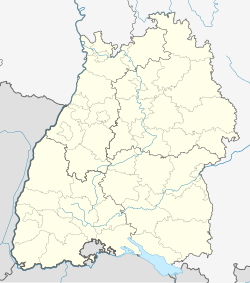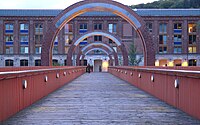
The Neckar is a 362-kilometre-long (225 mi) river in Germany, mainly flowing through the southwestern state of Baden-Württemberg, with a short section through Hesse. The Neckar is a major right tributary of the Rhine. Rising in the Schwarzwald-Baar-Kreis near Schwenningen in the Schwenninger Moos conservation area at a height of 706 m (2,316 ft) above sea level, it passes through Rottweil, Rottenburg am Neckar, Kilchberg, Tübingen, Wernau, Nürtingen, Plochingen, Esslingen, Stuttgart, Ludwigsburg, Marbach, Heilbronn and Heidelberg, before discharging on average 145 m3/s (5,100 cu ft/s) of water into the Rhine at Mannheim, at 95 m (312 ft) above sea level, making the Neckar its 4th largest tributary, and the 10th largest river in Germany. Since 1968, the Neckar has been navigable for cargo ships via 27 locks for about 200 kilometres (120 mi) upstream from Mannheim to the river port of Plochingen, at the confluence with the Fils.

Esslingen am Neckar is a town in the Stuttgart Region of Baden-Württemberg in southern Germany, seat of the District of Esslingen as well as the largest town in the district. Within Baden-Württemberg it is the 11th largest city.
Esslingen is a Landkreis (district) in the centre of Baden-Württemberg, Germany. Neighboring districts are Rems-Murr, Göppingen, Reutlingen, Böblingen and the district-free city Stuttgart.

Reichenbach an der Fils is a town in the Esslingen district in Baden-Württemberg in southern Germany.

Wernau is a town in the district of Esslingen in Baden-Württemberg southwestern Germany. It is situated on the Neckar river, 25 km southeast of Stuttgart.

Denkendorf is a municipality in the district of Esslingen in Baden-Württemberg in southern Germany. It is located 5 km south of Esslingen, and 14 km southeast of Stuttgart.

Altbach is a municipality in the district of Esslingen in Baden-Württemberg. It belongs to the Stuttgart Region. and the European Metropolitan Region Stuttgart.

Baltmannsweiler is a municipality in the district of Esslingen in Baden-Württemberg. It belongs to the Region Stuttgart. and the European Metropolitan Region Stuttgart.

Deizisau is a town in the district of Esslingen in Baden-Württemberg in southern Germany. It belongs to the Stuttgart Region (until 1992 Region Mittlerer Neckar) and the Stuttgart Metropolitan Region. Deizisau is located between the towns of Plochingen and Esslingen am Neckar, about 20 kilometers southeast of Stuttgart, the capital of Baden-Württemberg. The river Neckar flows through this town.
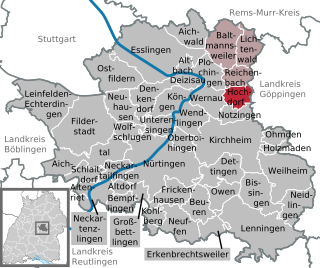
Hochdorf is a municipality in the district of Esslingen, Baden-Württemberg, in southern Germany. The mayors are Roland Erhardt and Gerhart Kuttler.

Köngen is a municipality in the district of Esslingen in Baden-Württemberg in Germany. About nine kilometers from the district city Esslingen am Neckar and about six kilometers away from Nürtingen. It is part of the Stuttgart Region and the European Stuttgart Metropolitan Region.

Lichtenwald is a municipality located in the Schurwald forest in the district of Esslingen in Baden-Württemberg in southern Germany. Situated on the state road L1151 between Reichenbach an der Fils and Schorndorf. It belongs to the Stuttgart Region and the European metropolitan region of Stuttgart.
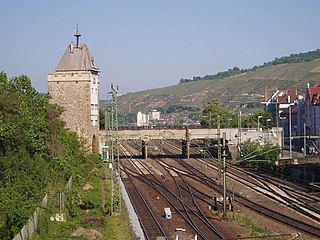
The Fils Valley Railway designates the Württemberg line from Stuttgart via Göppingen to Ulm. It runs from Plochingen to Geislingen an der Steige through the Fils Valley.

The Schurwald is a wooded mountain range in Baden-Württemberg, southern Germany, which at its highest point is 513.2 m above sea level.
The Plochingen–Immendingen railway is a main-line railway line in the German state of Baden-Württemberg. It runs from Plochingen via Horb am Neckar to Immendingen, following the upper reaches of the Neckar from Plochingen to Neckartailfingen and from Kirchentellinsfurt to Rottweil, and finally the Danube from Tuttlingen to the end of the line. It was therefore also historically known as the Obere Neckarbahn or the Obere Neckartalbahn. The Rottweil-Immendingen section used to be called the Obere Donaubahn or Obere Donautalbahn.

Esslingen (Neckar) station is the most important station in the town of Esslingen am Neckar in the German state of Baden-Württemberg and is located 13.2 kilometres (8.2 mi) from Stuttgart Hauptbahnhof on the Fils Valley Railway.

Plochingen station is the only station in the town of Plochingen in the German state of Baden-Württemberg and the most important railway junction of the Esslingen district. It is located 22.8 kilometres from Stuttgart Hauptbahnhof on the Fils Valley Railway and at the beginning of the Plochingen–Immendingen railway.
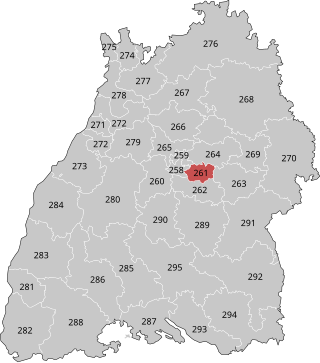
Esslingen is an electoral constituency represented in the Bundestag. It elects one member via first-past-the-post voting. Under the current constituency numbering system, it is designated as constituency 261. It is located in central Baden-Württemberg, comprising the northern part of the Esslingen district.

Nürtingen is an electoral constituency represented in the Bundestag. It elects one member via first-past-the-post voting. Under the current constituency numbering system, it is designated as constituency 262. It is located in central Baden-Württemberg, comprising the southern part of the Esslingen district.

Old Neckar is a nature conservation area designated by decree of the Regional Council Stuttgart on the territory of the municipality Altbach and the town Esslingen in the district of Esslingen in Baden-Württemberg. A 16.0-hectare (40-acre) area had already been placed under protection by decree of December 2, 1985.




